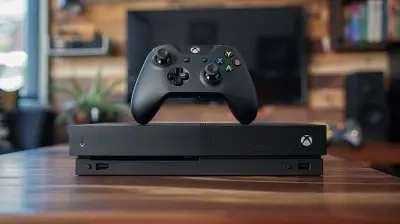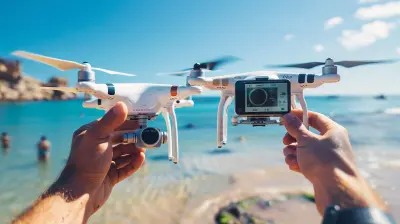The Role of Digital Twins in Enhancing Gadget Development
13 August 2025
Technology is evolving at a breakneck pace, and businesses are constantly looking for ways to stay ahead of the curve. One innovation that's reshaping the way gadgets are designed and developed is digital twins. But what exactly are digital twins, and how do they contribute to the creation of our favorite gadgets?
In this article, we’ll dive deep into the role of digital twins in gadget development, how they improve efficiency, and why they’re becoming an essential tool for engineers and designers.

What Are Digital Twins?
At its core, a digital twin is a virtual representation of a physical object, system, or process. Think of it like a highly detailed, real-time simulation of a gadget that can be tested, modified, and optimized before anything is physically built.Imagine you’re developing a new smartwatch. Instead of assembling a prototype every time you tweak a feature, you can make changes in a virtual environment and see how they would affect the real product. This minimizes costs, increases efficiency, and helps engineers detect potential failures before production.

How Digital Twins Are Used in Gadget Development
Digital twins are transforming the way gadgets are brought to life. From smartphones to wearables and even home automation devices, here’s how they’re making an impact:1. Faster Prototyping and Design Validation
Gone are the days when companies had to build multiple physical prototypes before getting a design right. With digital twins, engineers can test different materials, hardware configurations, and software features virtually, saving both time and money.For example, when designing a new smartphone, manufacturers can simulate how different screen resolutions impact battery life or how a new chipset affects performance. This allows them to fine-tune specifications before committing to production.
2. Improved Product Testing and Quality Assurance
Ever wondered how tech companies ensure their gadgets meet high durability and performance standards? Digital twins allow for rigorous testing under various conditions without damaging physical prototypes.- Durability Tests: Engineers can simulate drops, pressure, and stress factors to determine weak points in a gadget's structure.
- Thermal Performance: Digital twins help analyze heat dissipation in devices like laptops and gaming consoles.
- Battery Optimization: Battery consumption patterns can be tested under different usage conditions to maximize efficiency.
This means fewer defective products reaching customers and a much smoother user experience.
3. Predictive Maintenance and Reliability
One of the biggest headaches for tech companies is dealing with hardware failures after launch. With digital twins, maintenance issues can be predicted before they even arise.Take wireless earbuds, for instance. By creating a digital twin of the earbuds, manufacturers can simulate how real-world conditions—like repeated charging or exposure to humidity—affect the longevity of internal components. They can then tweak designs accordingly to increase durability before mass production.
4. Optimized Manufacturing Processes
Digital twins don’t just help in the design phase—they also play a crucial role in manufacturing. Companies can create twins of factories and production lines to monitor efficiency, pinpoint bottlenecks, and reduce waste.By simulating different manufacturing workflows, companies can fine-tune processes, reduce energy consumption, and minimize material waste, making production more cost-effective and sustainable.
5. Enhancing User Experience with Smart Analytics
Customers today expect smart gadgets that adapt to their needs, and digital twins help companies understand user behavior better. By collecting real-time data from actual products, companies can create AI-powered digital twins that analyze usage patterns and suggest improvements.For instance, smart home device manufacturers can track how users interact with their gadgets and tweak software updates accordingly. Think of it as giving a voice to gadgets, allowing them to communicate their needs and optimize their performance over time.

Real-World Examples of Digital Twins in Action
Several tech giants are already using digital twins to revolutionize their development processes. Here are some real-world examples:- Apple: Uses digital twins to test iPhone battery life and optimize thermal management.
- Tesla: Creates digital twins of its vehicles to gather real-time performance data and improve autonomous driving algorithms.
- Samsung: Uses digital twins in the R&D phase to design more energy-efficient displays and processors.
These companies are living proof that digital twins aren’t just a futuristic concept—they’re actively shaping the next generation of tech gadgets.

Challenges of Implementing Digital Twins in Gadget Development
While digital twins offer a ton of benefits, they’re not without their challenges. Here are some obstacles companies face in implementing them:1. High Initial Investment
Creating a digital twin requires advanced simulation software, real-time data integration, and AI-driven analytics, all of which come with a hefty price tag. Smaller companies may struggle to afford the upfront costs.2. Data Privacy and Security Risks
Since digital twins rely on real-time data collection from physical devices, data security becomes a major concern. Unauthorized access to digital twins could expose sensitive product information or even allow cybercriminals to manipulate designs.3. Complexity in Integration
Integrating digital twins into existing development and manufacturing processes can be difficult, especially for companies that still rely on manual testing and traditional design workflows.Despite these hurdles, the benefits of digital twins far outweigh the challenges. As technology progresses, these barriers are expected to diminish, making digital twins more accessible to companies of all sizes.
The Future of Digital Twins in Gadget Development
Looking ahead, digital twins are set to become even more powerful with advancements in AI, machine learning, and IoT connectivity. Here’s what we can expect:- Hyper-accurate Simulations: Machine learning will make digital twins even more precise in predicting real-world performance.
- Automated Design Improvements: AI will suggest optimized designs based on data collected from existing devices.
- Real-Time Adaptation: IoT-enabled gadgets will continuously update their digital twins, allowing manufacturers to provide instant software fixes and optimizations.
In short, digital twins are no longer a luxury—they’re becoming a necessity for companies that want to stay ahead in the competitive tech industry.
Final Thoughts
Digital twins are revolutionizing the way gadgets are designed, tested, and manufactured. They enable faster prototyping, enhance product reliability, optimize manufacturing, and even improve user experiences. While challenges like high costs and data security exist, the future of digital twins is incredibly promising.From smartphones to wearables and smart home devices, digital twins ensure that the gadgets of tomorrow are smarter, more efficient, and more reliable than ever before.
So, the next time you marvel at a sleek, cutting-edge gadget, remember—there’s probably a digital twin behind its success!
all images in this post were generated using AI tools
Category:
Technology InnovationAuthor:

Pierre McCord
Discussion
rate this article
1 comments
Jacob McFadden
Digital twins are revolutionizing gadget development, enabling rapid prototyping and enhanced simulations that streamline innovation and performance. The future is here!
August 27, 2025 at 4:12 AM

Pierre McCord
Thank you for your insightful comment! Indeed, digital twins are transforming gadget development by accelerating innovation and improving performance through advanced simulations.


